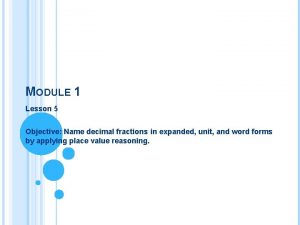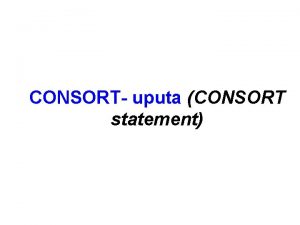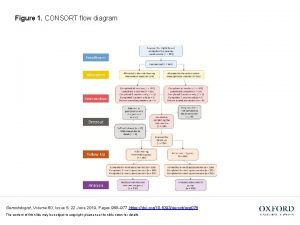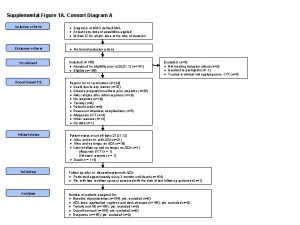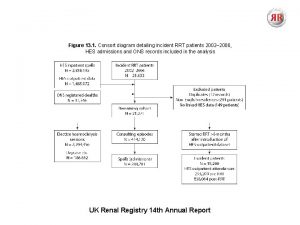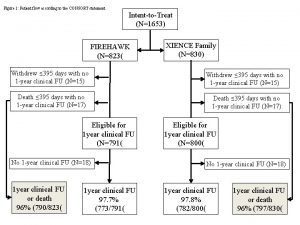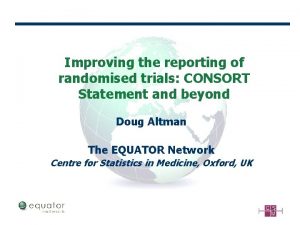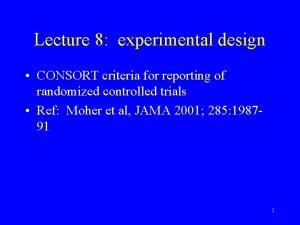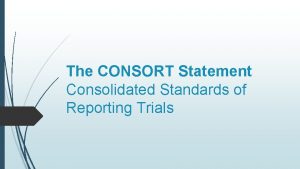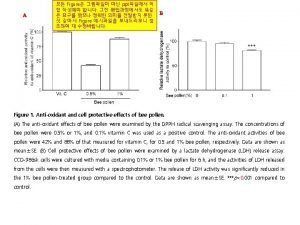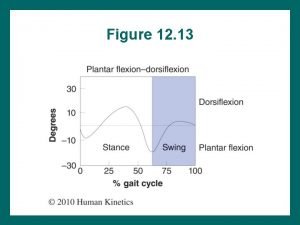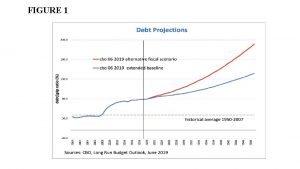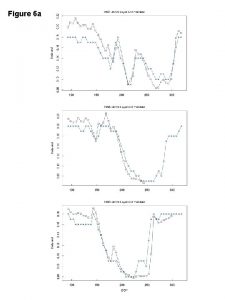Expanded CONSORT Figure for Planning and Reporting D



























- Slides: 27

Expanded CONSORT Figure for Planning and Reporting D & I Research Russell E. Glasgow, Ph. D Amy Huebschmann, MD, MS and friends ACCORDS Dissemination and Implementation Science Program Departments of Family and General Internal Medicine www. ucdenver. edu/accords/implementation www. evaluationhub. org

D & I Issues in Pragmatic Research External Validity/Pragmatic Criteria, often ignored § Participant Representativeness § Setting Representativeness § Multi-level Context and Setting § Adaptation/Change in Intervention and Implementation Strategies § Sustainability § Reasons for Participation and Drop Out

WHY Are These Important? § Understanding Context § Generalizability § Transparency in Reporting § Address Failure to Replicate

The RE-AIM Framework and External Validity Reporting www. re-aim. org Focus on enhancing: Reach – Participation rates and representativeness Effectiveness – Breadth (quality of life), including negative or unintended effects Adoption - Setting and staff participation rate and representativeness Implementation – Consistency, adaptation and costs to deliver the program Maintenance – Extent to which program and effects are sustained Gaglio B, et al. The RE-AIM Framework: A systematic review of use over time. Am J Public Health. 2013 Jun; 103(6): e 3846. Kessler RS, et al. What does it mean to “Employ” the RE-AIM Model? Eval Health Prof. 2012 Mar; 36(1): 44 -66.

Key Translation and Pragmatic Questions to Consider for the RE-AIM Dimensions RE-AIM Dimension Key Pragmatic Questions to Consider and Answer Reach Who is intended to benefit, and who actually participates or is exposed to the intervention? What is the most important benefits you are trying to achieve Effectiveness and what is the likelihood of negative outcomes? Adoption Where is the program or policy applied, and WHO applied it? Implementation How consistently is the program or policy delivered; How will Maintenance it be adapted; How much will it cost; and How/Why will the results come about? When will the initiative become operational; how long will it be sustained (setting level); and how long are the results sustained (individual level)?

Why Is This Important? Consider the DPP Case Study Impact of Loss at Each RE-AIM Concept Example of Translation of Interventions into Practice Dissemination Step RE-AIM Concept % Impact 50% of settings use intervention Adoption 50. 0% 50% of staff take part Adoption 25. 0% 50% of patients identified, accept Reach 12. 5% 50% follow regimen correctly Implementation 6. 2% 50% benefit from the intervention Effectiveness 3. 2% 50% continue to benefit after six months Maintenance 1. 6% www. re-aim. org

CONSORT Figure § CONSORT Figure and/or checklist required by most leading healthcare journals § Use associated with improved reporting and quality § Focused predominantly on internal validity

Enrollment Assessed for eligibility (n= ) Excluded (n= ) Randomized (n= ) Allocated to intervention (n= ) ¨ Received allocated intervention (n= ) ¨ Did not receive allocated intervention (why? ) (n= ) Lost to follow-up (give reasons) (n= ) Allocation Follow-Up ¨ Excluded from analysis (give reasons) (n= ) Allocated to intervention (n= ) ¨ Received allocated intervention (n= ) ¨ Did not receive allocated intervention (give reasons) (n= ) Lost to follow-up (give reasons) (n= ) Discontinued intervention (give reasons) (n= ) Discontinued intervention (why? ) (n= ) Analysed (n= ) ¨ Not meeting inclusion criteria (n= ) ¨ Declined to participate (n= ) ¨ Other reasons (n= ) Analysis Analysed (n= ) ¨ Excluded from analysis (give reasons) (n= )

Total Potential Participants (n) Individuals Eligible (n and %) Critical Considerations: CONSORT Figure - Reach Excluded by Investigator (n, %, and reasons) Individuals Decline (n and %) Not Contacted/Other (n and %) -Characteristics of Enrollers vs. Decliners ACCORDS – ADULT AND CHILD CENTER FOR HEALTH OUTCOMES RESEARCH AND DELIVERY SCIENCE University of Colorado Denver | Anschutz Medical Campus

Adoption: Setting and Staff Issues 1. Setting Level Adoption Factor Settings a. b. c. d. e. Who is invited/excluded Participation rate Who participates How representative are they Reasons for participating/declining 2. Staff Level Adoption Factors a. b. c. d. Who is invited/excluded Participation rate Who participates Reasons for participating/declining

Expanded CONSORT issue – Adoption Total Number Potential Settings Eligible (n and %) Settings and Agents Who Participate (n and %) Critical Considerations: Excluded by Investigator (n, %, and reasons) Settings and Agents Who Decline (n and %) Other (n and %) -Characteristics of Adopting Settings vs. Non -Characteristics of Adopting Staff vs. Non ACCORDS – ADULT AND CHILD CENTER FOR HEALTH OUTCOMES RESEARCH AND DELIVERY SCIENCE University of Colorado Denver | Anschutz Medical Campus

First Expanded CONSORT Figure REACH ADOPTION RE-AIM Issue Total Number Potential Settings Eligible (n and %) Settings and Agents Who Participate (n and %) Excluded by Investigator (n, % and reasons) Settings and Agents Who Decline (n and %) Other (n and %) Total Potential Participants (n) Individuals Eligible (n and %) Excluded by Investigator (n, %, and reasons) Individuals Enroll (n and %) Individuals Decline (n, %, and reason) Not Contacted/Other (n and %) ACCORDS – ADULT AND CHILD CENTER FOR HEALTH OUTCOMES RESEARCH AND DELIVERY SCIENCE University of Colorado Denver | Anschutz Medical Campus

DPP Example Adoption Data REACH ADOPTION RE-AIM Issue Total Number Potential Settings n=100 Settings Eligible n=75 Settings (and Agents) Who Participate n=40 (and 20) Excluded by Investigator n=25 and reasons Settings (and Agents) Who Decline and Reasons n=30 (and 20) Other n=5 (and 5) Total Potential Participants n=1000 Individuals Eligible n=800 Individuals Enroll n=400 Excluded by Investigator n=200 and reasons Individuals Decline n=300 and reason Not Contacted/Other n=100 ACCORDS – ADULT AND CHILD CENTER FOR HEALTH OUTCOMES RESEARCH AND DELIVERY SCIENCE University of Colorado Denver | Anschutz Medical Campus

Implementation Factors § Overall Level of Delivery of Key Components ‘Fidelity’ or Consistency of Delivery § Variability in Implementation and Outcomes Across: – – Staff Setting Time Patient sub-group – Adaptations made, same issues as above – Reasons for high and low levels

Expanded CONSORT issues – Implementation & Effectiveness EFFECTIVENESS IMPLEMENTATION RE-AIM Issue Extent Tx Delivered by Different Agents as in Protocol Complete Tx (n and %) Amount of Change (by Condition) Component A = XX% Component B = YY% etc. Adaptations and Reasons Drop Out of Tx (n, %, and reasons) Amount of Change (by Condition) Critical Considerations: -Factors Related to Fidelity (Implementation) and Adaptation -Characteristics of Drop-outs vs Completers (Effectiveness) ACCORDS – ADULT AND CHILD CENTER FOR HEALTH OUTCOMES RESEARCH AND DELIVERY SCIENCE University of Colorado Denver | Anschutz Medical Campus

RE-AIM Issue ADOPTION Total Number Potential Settings Second Expanded CONSORT Figure Excluded by Investigator (n, % and reasons) Settings Eligible (n and %) Settings and Agents Who Participate (n and %) Other (n and %) Settings and Agents Who Decline (n and %) IMPLEMENTATION EFFECTIVENESS REACH Total Potential Participants (n) Individuals Eligible (n and %) Excluded by Investigator (n, % and reasons) Individuals Enroll (n and %) Individuals Decline (n, %, and reasons) Extent Tx Delivered by Different Agents as in Protocol Component A = XX% Component B = YY% etc. Complete Tx (n and %) Amount of Change (by Condition) Not Contacted/Other (n and %) Adaptations and Reasons Drop Out of Tx (n, %, and reasons) Amount of Change (by Condition) ACCORDS – ADULT AND CHILD CENTER FOR HEALTH OUTCOMES RESEARCH AND DELIVERY SCIENCE University of Colorado Denver | Anschutz Medical Campus

Maintenance or Sustainability Level or Step § Patient Level: longer term follow-up than usual – When do you lose patients? – Who is lost? – Why are they lost or stop benefitting? § Setting Level Sustainability or Maintenance – – Do settings continue after research is completed? Do they discontinue program entirely? Do they modify/adapt the program or policy? Why? ? Chambers D and Glasgow RE (2013). The Dynamic Sustainability Framework: Addressing the Paradox of Sustainment amidst Ongoing Change. Implementation Science, 8(1): 117.

B) Setting Level A) Individual Level Expanded CONSORT issue – Maintenance Present at Follow-up (n and %) and Amount of Change or Relapse (By Condition) Setting in which Program in Continued and/or Modified After Research is Over (n, %, and reasons) Critical Considerations: Lost to Follow-up (n, %, and reasons) Amount of Change or Relapse (By Condition) Settings in which Program Adapted (n, %, and reasons) Settings in which Program Discontinued (n, %, and reasons) -Characteristics of Drop-outs vs. Completers (Individual) -Characteristics of Settings the Continue vs. Do Not ACCORDS – ADULT AND CHILD CENTER FOR HEALTH OUTCOMES RESEARCH AND DELIVERY SCIENCE University of Colorado Denver | Anschutz Medical Campus

Expanded CONSORT Figure RE-AIM Issue ADOPTION Total Number Potential Settings Excluded by Investigator (n, %, and reasons) Settings Eligible (n and %) Other (n and %) Settings and Agents Who Decline(n and %) Settings and Agents Who Participate(n and %) MAINTENANCE IMPLEMENTATION EFFECTIVENESS REACH Total Potential Participants (n) Individuals Eligible (n and %) Excluded by Investigator (n, %, and reasons) Individuals Enroll (n and %) Individuals Decline (n, %, and reasons) Extent Tx Delivered by Different Agents as in Protocol Complete Tx (n and %) Amount of Change (by Condition) Present at Follow-up (n and %) and Amount of Change or Relapse (By Condition) Setting in which Program is Continued and/or Modified After Research is Over (n, %, and reasons) Component A = XX% Component B = YY% etc. Not Contacted/Other (n and %) Adaptations and Reasons Drop Out of Tx (n, %, and reasons) Amount of Change (by Condition) Lost to Follow-up (n, %, and reasons) Amount of Change or Relapse (By Condition) Settings in which Program Adapted (n, %, and reasons) ACCORDS – ADULT AND CHILD CENTER FOR HEALTH OUTCOMES RESEARCH AND DELIVERY SCIENCE University of Colorado Denver | Anschutz Medical Campus Settings in which Program Discontinued (n, %, and reasons)

Questions? Comments thus far?

Qualitative Reporting Issues § To understand how and why results happen (especially reasons for participation and declining, in this case) § To provide more in-depth understanding of characteristics of those who participate vs. those who do not

Challenges to Using the Expanded CONSORT § Takes too much space – Already have to report CONSORT, figure added little § § § No money or time to collect necessary data No room in text for qualitative reasons ‘why and how’ Do not have data on many of these issues Do not want to know he answers or see these data Requires culture change

Why is it Important to Use the Expanded CONSORT? (or similar reporting approach) § To enhance transparency and indicate generalizability factors § To increase the frequency and quality of external validity reporting § To address the replication failure crisis § To succinctly and visually summarize key reporting issues § To align with evolving D&I reporting criteria (Sta. RI)

Standardized Criteria for Reporting Implementation Research (Sta. RI) 27 reporting criteria identified by systematic review and international experts, including: § § § § both implementation strategies and intervention effects related to, but expansion of, CONSORT criteria reporting of context, including SDOH and policy issues cost and economic outcomes fidelity and adaptations harm and unintended effects representativeness and estimated scalability Pinnock H. Barwick M, Carpenter CR, Eldridge S, Grandes G, et al. Standards for reporting implementation studies (Sta. RI) statement. BMJ 2017; 356: i 6795.

Summary § The Expanded CONSORT provides an efficient, transparent way to summarize key contextual and external validity issues § Greater use of it, along with Sta. RI and similar checklists, can enhance the quality of reporting and attention to these key D&I issues

Questions? Comments? I’m all ears.

References and Resources
 Domain 5: assessment and reporting
Domain 5: assessment and reporting How do you do 6 figure grid references
How do you do 6 figure grid references The ottoman empire grew and expanded after it conquered the
The ottoman empire grew and expanded after it conquered the Expanded ledger
Expanded ledger How many centimeters
How many centimeters He was born in1927 and expanded piaget's theory
He was born in1927 and expanded piaget's theory Formuö
Formuö Typiska novell drag
Typiska novell drag Tack för att ni lyssnade bild
Tack för att ni lyssnade bild Ekologiskt fotavtryck
Ekologiskt fotavtryck Shingelfrisyren
Shingelfrisyren En lathund för arbete med kontinuitetshantering
En lathund för arbete med kontinuitetshantering Kassaregister ideell förening
Kassaregister ideell förening Personlig tidbok fylla i
Personlig tidbok fylla i A gastrica
A gastrica Vad är densitet
Vad är densitet Datorkunskap för nybörjare
Datorkunskap för nybörjare Boverket ka
Boverket ka Debattartikel struktur
Debattartikel struktur Autokratiskt ledarskap
Autokratiskt ledarskap Nyckelkompetenser för livslångt lärande
Nyckelkompetenser för livslångt lärande Påbyggnader för flakfordon
Påbyggnader för flakfordon Tryck formel
Tryck formel Publik sektor
Publik sektor Jag har nigit för nymånens skära text
Jag har nigit för nymånens skära text Presentera för publik crossboss
Presentera för publik crossboss Vad är ett minoritetsspråk
Vad är ett minoritetsspråk Vem räknas som jude
Vem räknas som jude




